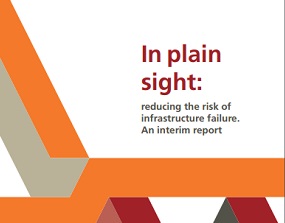In Plain Sight: reducing the risk of infrastructure failure
Contents |
[edit] Introduction
During his tenure, the out-going ICE President Tim Broyd asked Professor Peter Hansford of BRE to review whether the potential vulnerabilities in economic infrastructure are fully understood.
‘In plain sight: reducing the risk of infrastructure failure. An interim report’ is the first output from the review, published in November 2017.
The review does not investigate the details of the Grenfell Tower disaster, which are the subject of a public inquiry, nor does it specifically examine tower blocks or fire.
The Grenfell Tower fire was a profound shock for the country and raised the concern that any failings may be found to be systemic and not site specific. In these circumstances, organisations for professionals in all areas of the built environment sector should examine whether action needs to be taken to deliver safer and more effective whole-life stewardship of assets.
[edit] Background to the interim report
Much of infrastructure comprises legacy assets put to daily use by far more people than originally envisaged. For new assets, the procurement, funding and management techniques may be complex. This can cause difficulties around continuity of knowledge, vision and intent.
These and similar pressures impacting the nation’s infrastructure invite the question of whether there are increasing risks of infrastructure failure and, if already apparent – hiding in plain sight?
[edit] Interim report recommendations
The key lesson from previous incidents in infrastructure and other sectors is there is never one single cause of failure. Failures happen when multiple factors align at a single point in time, for example: human error; poor design; weather conditions, etc.
The Panel’s interim conclusions are the result of a two month period of study and consultation. The Panel has found that while the risk of a major failure of UK infrastructure is relatively low, it is still not low enough. ICE should, work with government and other stakeholders, to consider afresh what steps are necessary to reduce further risks of failure.
The interim report has four main areas of recommendation:
[edit] Validation
ICE should commission a study to analyse and validate the 12 lines of defence against infrastructure failure in the model set out in this interim report.
[edit] Lesson sharing
ICE should work with other infrastructure organisations to improve how the sector shares information from safety reviews, accidents, failures and near misses.
[edit] Competence
ICE should review the robustness of its Continuing Professional Development regime and Professional Code of Conduct. ICE should also review the effectiveness of arrangements for professional oversight of assets in different sub-sectors of infrastructure.
[edit] Governance
ICE should work with other infrastructure organisations to identify if improvements can be made to the governance role in the development and management of assets. This should include the competence of boards, scrutiny systems and the presence of a technically competent engineering voice in safety-critical decisions.
In addition to commissioning a study on the 12 lines of defence, the Panel recommends establishing three Task and Finish groups to take forward the three areas of Lesson sharing, Competence and Governance.
You can download the report here.
This article was originally published here by ICE on 6th Nov 2017. It was written by Gavin Miller.
--The Institution of Civil Engineers
[edit] Related articles on Designing Buildings
- Articles by ICE on Designing Buildings Wiki.
- Avoiding disaster in existing buildings and infrastructure.
- Building our Industrial Strategy: green paper.
- Five key themes for global infrastructure policy in 2021.
- Government construction and infrastructure pipelines.
- Highways Infrastructure Asset Management Plans.
- In Plain Sight: Assuring the whole-life safety of infrastructure.
- Infrastructure.
- National Infrastructure Commission.
- National Infrastructure Plan.
- National Infrastructure Plan for Skills.
- Structural failures prompt recognition of complex management systems.
- Uncertainty in the civil engineering profession.
Featured articles and news
RTPI leader to become new CIOB Chief Executive Officer
Dr Victoria Hills MRTPI, FICE to take over after Caroline Gumble’s departure.
Social and affordable housing, a long term plan for delivery
The “Delivering a Decade of Renewal for Social and Affordable Housing” strategy sets out future path.
A change to adoptive architecture
Effects of global weather warming on architectural detailing, material choice and human interaction.
The proposed publicly owned and backed subsidiary of Homes England, to facilitate new homes.
How big is the problem and what can we do to mitigate the effects?
Overheating guidance and tools for building designers
A number of cool guides to help with the heat.
The UK's Modern Industrial Strategy: A 10 year plan
Previous consultation criticism, current key elements and general support with some persisting reservations.
Building Safety Regulator reforms
New roles, new staff and a new fast track service pave the way for a single construction regulator.
Architectural Technologist CPDs and Communications
CIAT CPD… and how you can do it!
Cooling centres and cool spaces
Managing extreme heat in cities by directing the public to places for heat stress relief and water sources.
Winter gardens: A brief history and warm variations
Extending the season with glass in different forms and terms.
Restoring Great Yarmouth's Winter Gardens
Transforming one of the least sustainable constructions imaginable.
Construction Skills Mission Board launch sector drive
Newly formed government and industry collaboration set strategy for recruiting an additional 100,000 construction workers a year.
New Architects Code comes into effect in September 2025
ARB Architects Code of Conduct and Practice available with ongoing consultation regarding guidance.
Welsh Skills Body (Medr) launches ambitious plan
The new skills body brings together funding and regulation of tertiary education and research for the devolved nation.
Paul Gandy FCIOB announced as next CIOB President
Former Tilbury Douglas CEO takes helm.
UK Infrastructure: A 10 Year Strategy. In brief with reactions
With the National Infrastructure and Service Transformation Authority (NISTA).
























